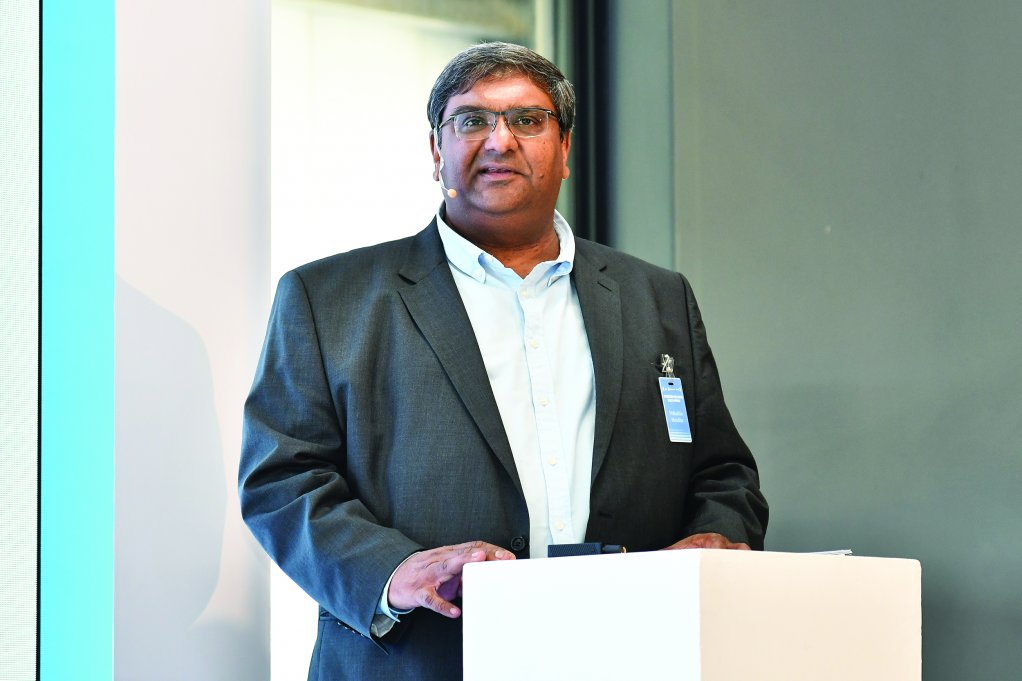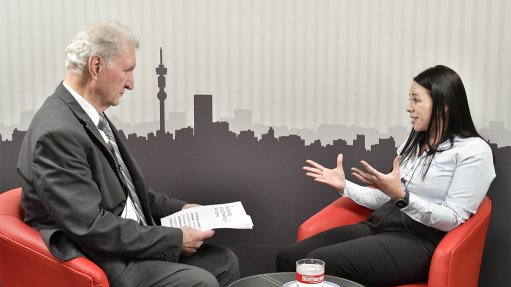BMW’s hydrogen-fuelled cars take to local streets for first time









BMW, Anglo American Platinum, Sasol talk to Mining Weekly’s Martin Creamer on the new BMW iX5 Hydrogen taking to South Africa’s streets. Video: Darlene Creamer.
The hydrogen passenger car promoted by BMW hydrogen programme director Deena Govender.
Photo by Creamer Media Chief Photographer Donna Slater
BMW Group programme manager hydrogen technologies Dr Juergen Guldner.
Photo by Creamer Media Chief Photographer Donna Slater
Anglo American executive head projects and environment Prakashim Moodliar.
Sasol principal market development specialist green hydrogen Dries Swanepoel.
Photo by Creamer Media Chief Photographer Donna Slater
The hydrogen roadmap of Hydrogen South Africa.
Deena Govender Africa is going to become a large exporter of green hydrogen to the north
Photo by Creamer Media's Donna Slater
Sasol principal market development specialist green hydrogen Dries Swanepoel.
Photo by Creamer Media's Donna Slater
The hydrogen roadmap of Hydrogen South Africa.
For the first time, luxury vehicle manufacturer BMW has a fleet of hydrogen-fuelled cars on South Africa’s roads, supported by a green hydrogen refuelling infrastructure set up at its campus in Midrand, Johannesburg.
The outcome of BMW, Anglo American Platinum (Amplats) and Sasol finding common ground was the launch on Valentine’s Day of the heavenly BMW iX5 Hydrogen passenger car, which Engineering News & Mining Weekly can confirm infinitely outstrips the ‘sheer driving pleasure’ slogan of the already top-rated BMW mobility brand.
Tested by enthusiastic media on local South African roads, the BMW iX5 Hydrogen combines long-distance capability and short refuelling stops with emission-free driving – an absolutely necessary advance to save Mother Earth from climate change catastrophe.
The BMW iX5’s 6 kg of hydrogen allows for a 500 km range, with the car’s platinum-based fuel cell turning green Sasol hydrogen into perfectly clean electricity that powers the quiet drive train.
It is no coincidence that South Africa, with its superior sun, prime wind and abundance of platinum group metals (PGMs), is one of only ten countries currently traversed by BMW’s latest green hydrogen masterpiece.
What the car world loves about hydrogen is that it is not only the planet’s most abundant energy source but that it is also a transport vector with a storage magnitude that ensures that renewable energy can be offered even when the sun is not shining and the wind is not blowing.
Growing the market for hydrogen-fuelled mobility solutions has been declared a key pillar of the South African government’s green hydrogen economy strategy, which will lower carbon emissions meaningfully, unlock investment enormously, create jobs, and drive demand for this country’s magical PGMs.
Although hydrogen has unrivalled attributes, including having more than three times the gravimetric energy density of conventional fuel, as with any new technology adoption, it has a competitive path to tread.
But it must be borne in mind that one cannot get a more sustainable fuel than hydrogen with 75% of the entire universe being hydrogen and 70% of Planet Earth being covered by water, made up of a hydrogen molecule and two oxygen molecules.
There are no carbon emissions in creating it from renewable sources and there are no carbon emissions in using it as the by- products are heat, electricity and water.
“We are going to see this unique little element offer us a potential way out of our climate crisis,” BMW hydrogen programme director Deena Govender commented to Engineering News & Mining Weekly.
“I think Africa is going to become a large exporter of green hydrogen to the north. Because we have the wonderful endowment of solar and wind power, we are going to be able to transform that and store it as hydrogen and maybe we should be looking at transforming our refineries along the coast to processing liquefied hydrogen and exporting that to the rest of the world,” Govender added.
Owing to the state of geopolitics, more countries are targeting energy independence through renewables and hydrogen.
The key takeaway of the discussion at the launch event was that collaboration is going to be key given that the hydrogen economy spans so many industries.
Anglo American executive head of projects and environment Prakashim Moodliar described as fantastic the collaboration already under way with BMW and Sasol on the demonstration launch of the BMW iX5 Hydrogen in South Africa.
“The hydrogen economy unpacks fantastic value for South Africa and for us as PGM miners, with platinum and iridium used both in the generation of green hydrogen and the opportunities in PEM electrolysers in the fuel cell electric vehicle (FCEV),” Moodliar added.
One of South Africa’s big economic opportunities is to decarbonise the vehicles on its roads and FCEVs allow for the best of electric vehicles minus emissions while still allowing for conventional travel distance and refuelling time.
Anglo started on this journey two years ago with the launch of its zero-emissions haulage solution at the Mogalakwena PGMs mine in Limpopo, where it ran a fuel cell in a 510 t truck, which is now being upgraded from a user of gaseous fuel into a user of liquid fuel.
A transition of 6% to 7% of FCEVs globally could see a potential for two- to five-million ounces of platinum demand.
“We think that hydrogen vehicles are part of the future of zero-emission mobility and many people are talking about hydrogen in heavy-duty trucks, but we think that hydrogen also plays a role in light-duty vehicles and passenger cars,” BMW Group programme manager: hydrogen technologies Dr Juergen Guldner emphasised.
“The hydrogen car basically is an electric car. It uses hydrogen as the energy instead of electricity that is stored in a battery but you have all the advantages of electric drive, like the great acceleration, silent ride, zero emission and, because it’s hydrogen, you can refuel the cars in just three to four minutes,” Guldner added.
Sasol has begun to feed its 60 MW electrolyser on site at Sasolburg with 3 MW of solar energy generated on the premises.
That has enabled the company to commence the production of 150 kg of green hydrogen a day.
While that is under way, the commissioning of a wind farm project being developed in the Eastern Cape is imminent to allow for the feeding in of 65 MW of renewable power into its Sasolburg electrolyser.
That will enable Sasol to produce 3.5 t of green hydrogen a day at commercial scale.
“We believe there is a role to play, especially in the hard-to-abate, heavy-duty segment of transport and there we’re working with several of our partners to explore what is it that we can do and how do we get hydrogen into these vehicles,” Sasol principal market development specialist: green hydrogen Dries Swanepoel highlighted.
“From a behaviour perspective, the refuelling experience is the same, filling up time is the same as what we experience today with petrol and diesel, and with the partners like BMW and Toyota that we are collaborating with, we’ve got vehicles already in the country that are being refuelled.
“Hydrogen is going to play a strategic role within a decarbonised world and particularly within passenger vehicles,” said Amplats principal: market development Fahmida Smith, who described the partnership with BMW and Sasol as being key to showcase the green hydrogen mobility in South Africa.
“But as Anglo American Platinum, we do very similar work on a global basis. We have a 200-taxi fleet with light passenger Toyota Mirai vehicles on the road in Berlin and we are looking at how to promote FCEVs because they are going to be important for us in South Africa as the PGMs industry because our platinum goes into the beautiful vehicles that are on display today,” Smith said.
“Within a green hydrogen environment, we’re going to see uptake of our PGMs. Within the hydrogen production, iridium plays a crucial role and platinum plays a crucial role within FCEVs.
“Some of our initial calculations say that taking in the global vehicle market . . . targeting between 5% and 7% of the global vehicle market for FCEVs, it can be anything between 2.5-millon to four-million troy ounces of platinum per annum. So, that is meaningful demand from the sector.
“Green hydrogen is considered a renewable energy because with green hydrogen you are harvesting your energy from the sun. You are using water which you split to generate hydrogen. There are other means of generating hydrogen as well but that’s the way you get green hydrogen and the nice thing about hydrogen is that it’s going to be a key vector in terms of decarbonising the hard-to-abate sectors,” said Smith.
Comments
Press Office
Announcements
What's On
Subscribe to improve your user experience...
Option 1 (equivalent of R125 a month):
Receive a weekly copy of Creamer Media's Engineering News & Mining Weekly magazine
(print copy for those in South Africa and e-magazine for those outside of South Africa)
Receive daily email newsletters
Access to full search results
Access archive of magazine back copies
Access to Projects in Progress
Access to ONE Research Report of your choice in PDF format
Option 2 (equivalent of R375 a month):
All benefits from Option 1
PLUS
Access to Creamer Media's Research Channel Africa for ALL Research Reports, in PDF format, on various industrial and mining sectors
including Electricity; Water; Energy Transition; Hydrogen; Roads, Rail and Ports; Coal; Gold; Platinum; Battery Metals; etc.
Already a subscriber?
Forgotten your password?
Receive weekly copy of Creamer Media's Engineering News & Mining Weekly magazine (print copy for those in South Africa and e-magazine for those outside of South Africa)
➕
Recieve daily email newsletters
➕
Access to full search results
➕
Access archive of magazine back copies
➕
Access to Projects in Progress
➕
Access to ONE Research Report of your choice in PDF format
RESEARCH CHANNEL AFRICA
R4500 (equivalent of R375 a month)
SUBSCRIBEAll benefits from Option 1
➕
Access to Creamer Media's Research Channel Africa for ALL Research Reports on various industrial and mining sectors, in PDF format, including on:
Electricity
➕
Water
➕
Energy Transition
➕
Hydrogen
➕
Roads, Rail and Ports
➕
Coal
➕
Gold
➕
Platinum
➕
Battery Metals
➕
etc.
Receive all benefits from Option 1 or Option 2 delivered to numerous people at your company
➕
Multiple User names and Passwords for simultaneous log-ins
➕
Intranet integration access to all in your organisation



























